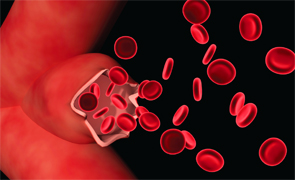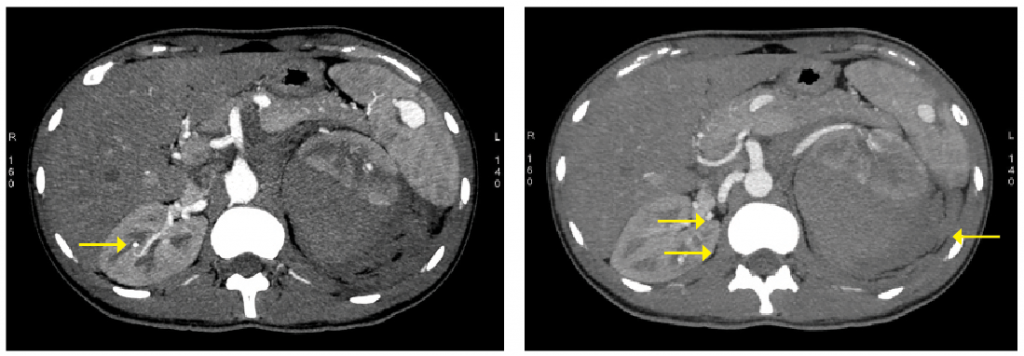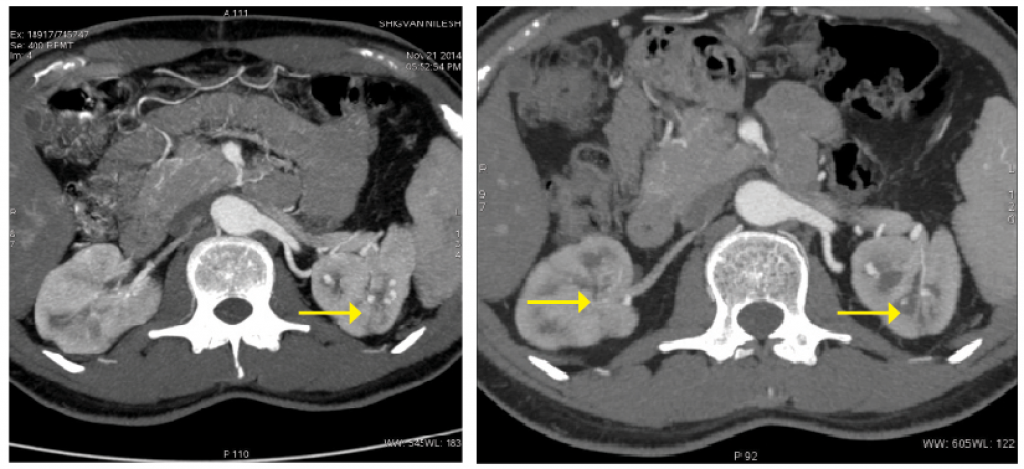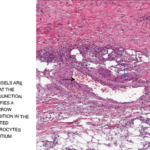
Image Credit: BioMedical/shutterstock.com
Case report: A 27-year-old male was referred to the rheumatology outpatient department in February 2015 from the urology department after complaining of recent-onset uncontrolled hypertension (220/160 mmHg), headache and vomiting.
In 2010, he was admitted to the urologist for sudden-onset left lumbar region pain and recent-onset hypertension. Clinical examination and the blood tests were normal. CT angiography of the abdomen suggested a ruptured aneurysm with subcapsular and para-renal hematoma around the left kidney. Multiple aneurysms were present in the intra-renal vessels on the left and right kidneys. Aneurysms were also present in the lower pole of the spleen and branches of the splenic artery. The abdominal aorta and its major vessels were normal at their origin (see Figures 1 & 2).
Emergent exploratory laparotomy was performed, with evacuation of the hematoma. A diagnosis of medium vessel vasculitis–polyarteritis nodosa (PAN) was made, and immunosuppressive therapy with steroids was advised at the time of discharge. However, the patient had not participated in follow-up visits until the present consultation.

(click for larger image)
Figure 1: A splenic, right renal aneurysm with left para-renal hemorrhage is shown in the CT.
Figure 2: Multiple right renal aneurysms with left para-renal hemorrhage are shown in the CT.
Upon presentation, the patient’s examination was normal except for hypertension. Inflammatory markers and all other labs were normal. Repeat CT angiography showed the presence of multiple new aneurysms involving peripheral intra-renal branches on both sides (see Figure 3).
Given the presence of new aneurysms and uncontrolled hypertension, the patient was started on oral prednisolone at 40 mg/day and was given three pulses of IV cyclophosphamide, each at 500 mg, two weeks apart. Following the three pulses, he was asymptomatic, his inflammatory markers were normal, and his blood pressure had been reduced to 170/90 mmHg.

(click for larger image)
Figure 3: Pretreatment, multiple bilateral intra-renal aneurysms are present.
Figure 4: Post-treatment, significant resolution of the aneurysms bilaterally is apparent.
A repeat CT angiography was performed to monitor response to treatment and help guide further treatment. The repeat scan demonstrated significant reduction in the size and number of aneurysms bilaterally (see Figure). Thus, we decided to continue treatment with three additional pulses of cyclophosphamide.
Discussion
PAN is a necrotizing systemic vasculitis involving the medium and small arteries, characterized by the presence of aneurysms and stenosis of medium-sized visceral arteries on angiography, absence of glomerulonephritis and negative serology for ANCA.1 The classification criteria for PAN were proposed by the Chapel Hill Consensus Conference (CHCC 2012), the American College of Rheumatology (ACR 1990) criteria and the French Vasculitis Study Group criteria (2008).1,2,8 There are no diagnostic criteria.3


